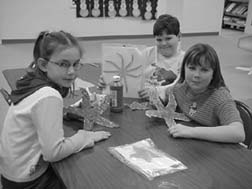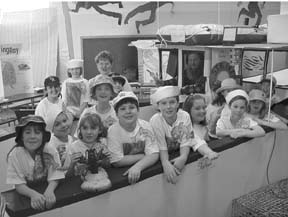| |
Archives:
Spring 2002 Table
of Contents
Adopt-A-Boat
Links Fishermen and Educators
by Andrea Cohen, MIT Sea Grant
Tim Alley,
captain of the 72-foot trawler, the Bay Flyer, is accustomed to
long, rough days at sea. But recently he found himself barraged,
not by weather or waves or regulations, but by questions from a
couple crackerjack cub reporters—second-grade students visiting
from South Bristol Elementary School. The students and Alley are
participants in Adopt-a-Boat, an innovative new project in which
New England fishermen partner with local educators and their classes.
The collaborative program uses commercial fishing boats as a vehicle
for teaching K-12 students about marine resource utilization, marine
ecology, and life as a fisherman. The project is funded by the Northeast
Consortium and coordinated by MIT Sea Grant (MITSG).
Adopt-a-Boat got its start at a meeting of Fleetlink—a project
in which fishermen partner with scientists, using their vessels
as research platforms. Cameron McClellan, captain of the Adventurer
of Portland, noted that the data he'd collected was already being
used at his son's school in New Hampshire. "We immediately
realized that this kind of partnership was a natural activity,"
says Cliff Goudey, MITSG's marine advisory leader. He and Brandy
Moran, MITSG education coordinator, then set about lining up the
11 classrooms and eight fishermen for the first year's pilot project.
|
|
| Jeannine
Brady's third-grade class at Vermont's Canaan Elementary, in
the replica they constructed of the F/V Striker, complete with
Captain Mattie Thomson. |
While the concept of stewardship via "adopt-a-something"
programs isn't new, Adopt-a-Boat differs from other such programs,
says project coordinator Moran. "A lot of those programs are
related to a specific location or environment," she says. "This
is related to an industry." Goudey adds that Adopt-a-Boat is
special "because of the depth of support we're prepared to
give to make the partnerships work." Along with funds and time,
this support has included supplies such as nautical charts for teachers,
digital cameras for all fishermen, and computers for some, since
electronic communication is critical for spanning distances between
boats and classes.
Flexibility has proven key to the program. "We work with each
teacher to help figure out how Adopt-a-Boat can work with his or
her class," says Moran. "Partly this is because we are
dealing with such a wide range: K-12." Currently, the project
involves schools in Massachusetts, Maine, New Hampshire, and Vermont.
The fishermen are based in Maine and Massachusetts and fish the
Gulf of Maine and Georges Bank with a variety of vessel types.
Partnerships involve visits to classes and vessels, and regular
email exchanges. At Kimball Union Academy in Meriden, NH, Dean Goodwin's
9th grade and Advanced Placement environmental students are conducting
research projects using real-time data telemetered from McClellan's
trawler. Goodwin and his students also took an overnight research
cruise with McClellan, gaining hands-on experience with the vessel's
technology, equipment, and safety procedures.
At Essex Agricultural High School, Amy Holt Cline's 11th grade students
are paired with Nino Randazzo, captain of the Skimmer, out of Gloucester,
Mass. Cline's students are analyzing Randazzo's catch data and will
use GIS technology to make maps showing how permanent and rolling
fishing closures, shipping lanes and marine sanctuaries play a role
in keeping the Gulf of Maine a sustainable resource. Students are
also learning about groundfish biology by raising fish in a 100-gallon
re-circulating system built by Moran and Goudey. The class also
plans to visit with National Marine Fisheries Services officials
to better understand the regulations that govern New England fisheries.
Third graders in Jeannine Brady's class at Canaan Elementary were
able to pose questions on videotape to their Maine fisherman, Mattie
Thompson. In turn, Thompson was videotaped aboard the Striker in
Monhegan Bay showing the Vermont students the difference between
male and female lobsters and just how lobster gear works.
 |
| Students
in Lee Ann Kinen's 3rd grade at Maine's Houlton Elementary mkaing
ocean boxes. |
For students
and teachers, the partnerships allow a meaningful introduction to
the fishing industry, marine science, coastal management and more.
The incentives for busy fishermen to get involved are varied. Chris
Andrews, captain of the November Rain, out of Portland, Maine, is
partnering with Margaret Morton's 7th and 8th graders at South Bristol
Elementary School, in South Bristol, Maine. He says, "I like
working with kids and it’s good to give something back."
And like others, Andrews notes that the partnerships provide an
opportunity to give the public a better representation of fishermen.
"Fishermen get a bad rap from the press, but we’re the
most environmentally conscious people because we have to make a
living from the environment," he says.
The partnerships also allow fishermen to simply share their enthusiasm
for their profession. "It's a job and a religion and a way
of life all rolled into one. And it's a hobby too," says Mattie
Thompson. What would Nino Randazzo tell youngsters interested in
fishing for a living? "I'd tell them that it's a beautiful
thing," he says. But he adds what any fisherman will note,
that the fishing life has changed dramatically due to ever changing
and more restrictive regulations. Craig Pendleton, captain of the
Susan & Caitlyn, out of South Portland and Newcastle, Maine,
was also involved with Fleetlink and sees education as a way of
helping fishing communities "return to looking at fishing as
an integral part of the community."
 |
|
Houlton
students and five-armed friends.
|
Part of what
makes the program work so well, says Goudey, may well be the fact
that teachers and fishermen share much in common. He points out
that both professions draw highly committed individuals who often
could not conceive of other professions. "Teaching and fishing
both involve oft-repeated tasks," he comments, "and the
outcome is never predictable." And both teachers and fishermen
have found that their work environments have grown remarkably more
complex with increased regulations.
Plans for the project's second year call for an increased number
of fishing boats, and the participation of some 100 classrooms in
the Northeast. All the first-year classes have signed up for year
two, and another 50 have already expressed interest in getting aboard.
As to the success so far, Goudey says: "It was an idea whose
time had come or was way overdue. That's usually what makes a project
sizzle."
Visit www.adoptaboat.org
for more details.
Return
to Top
|



